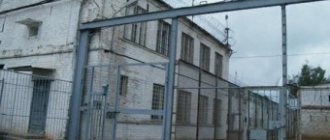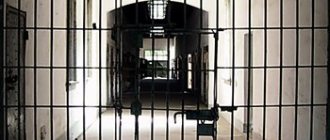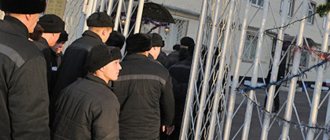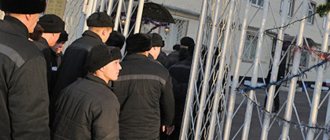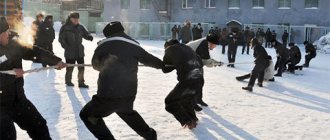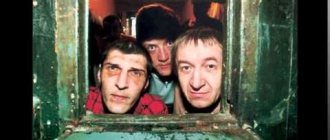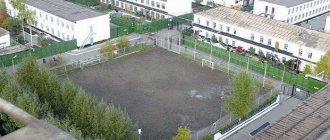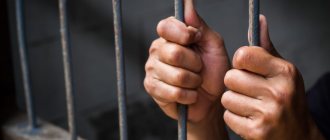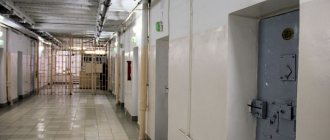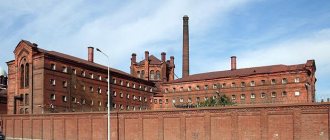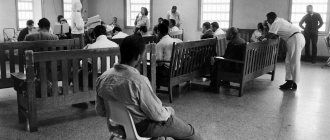The main entrance to the Vologda Pyatak
The prison for criminals who received life sentences, located on Ognenny Island in the middle of Lake Novy in the Vologda Region, can be safely called “Russian Alcatraz.” Just like its American sister city, it is separated from the land on all sides by the cold water of a northern reservoir, and the maintenance regime is considered one of the most severe. Not a single prisoner has managed to escape from it in its entire long history. The name of the Russian analogue of Alcatraz is popularly called Vologda Pyatak, and in official documents it is called FKU IK-5 of the Federal Penitentiary Service for the Vologda Region. However, the prison changed its names several times.
The first mention of people who set foot on the island dates back to 1517. The pioneer was the monk of the Korniliev-Komelsky monastery, Kirill. He searched for a long time and finally found a place completely suitable for absolute solitude, where he could indulge in prayers to God. In those distant times, the island on the lake was called Red. The places there are really very picturesque. A few years later, several more monks joined Cyril.
Together they founded the Kirillo-Novoezersky Monastery, the walls and buildings of which now serve as a maximum security prison. The history of the monastery began during the time of Ivan the Terrible's father, Grand Duke of Moscow Vasily the Third. All Russian sovereigns paid a lot of attention to one of the northern monasteries. Peter the Great and the future Empress Elizabeth the First visited it.
Vologda nickel
Next to the monastery is the ancient city of Belozersk, where disgraced boyars were often sent into exile, but a prison appeared on Ognenny Island immediately after Soviet power came to the Vologda region. In 1918, all the monks were expelled from the island. Instead, revolutionary-minded people in “boots and leather jackets” began to settle in the monastery. With them appeared their wards “enemies of the people” - representatives of socially alien classes.
“Enemies of the people” were kept in the monastery cells for the next few decades. Only closer to the war, instead of nobles, white officers and merchants, most of the “political criminals” were Soviet party and economic figures who fell under the moloch of Stalin’s repressions. Perhaps among them were the same people in “boots and leather jackets” who changed the status of the ancient monastery. The Kirillo-Komelsky Monastery was quickly forgotten. Now it was called the Novoyezerskaya ITC or generally impersonal - a maximum security camp. The faces of the saints were thickly smeared with a thick layer of fresh plaster.
Brief characteristics of MLS
The institution is a special regime men's correctional colony for those sentenced to life imprisonment. According to the Order of the Ministry of Justice of the Russian Federation “On changing the type of regime and occupancy limits of correctional institutions ...” dated August 17, 2012 No. 162, the occupancy limit is 505 places, including a high-security section with 55 places.
The colony is located on Ognenny Island, located on Lake Novozero near the city of Belozersk, in the Belozersky district of the Vologda region.
- Institution address : 161222, Vologda region, Belozersky district, Ognenny Island, 16.
- Institution email address
| Position, rank | FULL NAME. | Days and hours of reception of citizens | Phone number for making an appointment |
| Head of the institution, colonel of the internal service | GORELOV Vladimir Ivanovich | Tuesday, 10 a.m. to 12 p.m. | (817-56) 3-85-07 |
| Deputy Chief, Lieutenant Colonel of Internal Service | DASHKOVSKY Igor Vladimirovich | Monday, 10 a.m. to 12 p.m. | (817-56) 3-85-07 |
| Deputy Chief, Lieutenant Colonel of Internal Service | MAKSIMOV Andrey Vladimirovich | Thursday, 10 a.m. to 12 p.m. | (817-56) 3-85-07 |
| Deputy Chief, Major of Internal Service | CHEKIN Konstantin Sergeevich | Thursday, 10 a.m. to 12 p.m. | (817-56) 3-85-07 |
| Deputy Chief - Head of the Central Administrative District, Lieutenant Colonel of the Internal Service | MELNIKOV Andrey Nikolaevich | Wednesday, 10 a.m. to 12 p.m. | (817-56) 3-85-07 |
The head of the correctional commission and his deputies, at specially allotted times, receive citizens on issues of serving the sentence of those sentenced to imprisonment.
Applications for visits, transfers and money transfers for prisoners are considered only by the head of the colony.
Information about IK-5 can be obtained on a special page of the GUFSIN website https://www.35.fsin.rf/stru%D1%81ture/fku-ik-5/ or on the page of the electronic directory of prisons of the Russian Federation https://fsin- atlas.ru/catalog/object/ik5ognen/. There are also pages on social networks dedicated to the colony :
- https://vk.com/club23235570;
- https://vk.com/tyragamegayron.
According to the rules of the institution, visiting convicts is allowed twice a year. Long-term and short-term visits are carried out on weekdays, weekends and holidays at the same time: 07.45-17.15. Long-term visits (for three days) are allowed only after 10 years in prison. Short-term meetings last four hours. Their order and timing are regulated by Art. 89 Penal Code of the Russian Federation.
To receive a visit, you must have permission from the head of the institution, which can be obtained by submitting a special application. It can be completed in writing or electronically on the colony page on the GUFSIN website. If there are no legal grounds for refusal, then written permission to visit is issued. If a visit is refused, the reasons for the refusal are indicated on the application .
"We have no hope"
In 1989, 47-year-old Gennady Ilyakhin made a daring escape from the Gornoaltaisk pre-trial detention center, where he was awaiting transfer after being sentenced for car theft. They gave me seven years. The 19-year-old boy was persuaded to escape by his adult cellmates. The attackers attacked the guards and took possession of weapons. Four policemen were wounded. For three days the accomplices hid in the forests. After the arrest, the organizer of the escape hanged himself, another participant received 15 years in prison, and Gennady was shot. Later the punishment was changed to PLS, that is, life imprisonment.
“Cruel punishment,” sums up the man after 27 years in prison. As an example, he cites prisoners from the household service detachment (in IK-5, “conscripts” are employed in various small jobs, that is, convicts with deadlines), some of whom received 15-20 years for murder.
Employees of the Federal Penitentiary Service confirm that part of the Pyatak contingent, according to modern laws, would never have received PLC, as happened during the criminal law of the USSR.
Last year, the convicted Ilyakhin wrote a petition to the court for parole. The Belozersky District Court refused.
“I have housing, relatives, and acquaintances when I’m free; I would go to work and live somewhere near a monastery,” the prisoner imagines. - I became a believer. I haven’t seen life, and now I don’t want to. I asked the court for the addresses of the police officers of the victims, I wanted to apologize, but they didn’t give me one. A lot of water has flown under the bridge. There is a lot of free time here, all the time is free, and you go through everything thousands of times and realize it. We have no hope. We watch TV, we like Putin, we don’t have anything better than him. But Putin said that while he is at the helm, not a single rapist or murderer will be pardoned, and Putin does what he says. He won't deceive. So none of us will get out.”
Photo
Next in the photo you can see what the Vologda Pyatak colony looks like.
Infrastructure
The colony itself is a complex of four buildings. The cells in it will be more spacious, with ventilation and sewerage, which is missing in the old premises for prisoners. One of the buildings is located in the building of a former monastery, which is already 500 years old. The remaining buildings are modern, built within the last 5-20 years and consist of three floors.
The territory of the Fiery One is small, so the colony occupies all of it. The island is connected by a wooden bridge with another one, Sladkoye, where the institution’s employees live. Fiery does not have direct communication with the mainland , and there is also no mobile communication on the island.
Conditions of detention
All life prisoners live in IK-5 not in barracks, as is customary in such institutions, but in special cells. The standard room area is 6 square meters per person. There are two prisoners per cell, and one for the mentally unstable.
Prisoners are selected in a special way to be in the cell. For example, so that convicts prone to escape do not end up in the same cell, or a pedophile maniac does not end up next door to someone who still has children at large.
The cell's furnishings are minimalist: each prisoner has a bed, a stool and a shelf for personal belongings, and a common table. The sanitary and “living” parts of the cell are separated: the sink and toilet are located in the adjacent room. The institution is equipped with television monitors that constantly monitor the actions of convicts .
On the door of each cell hangs a special sign with a photograph of the prisoner in it and a list of his crimes. This is done to keep employees alert.
After serving the first ten years in the colony, the conditions of detention are slightly relaxed, and radios or televisions are allowed to be installed in the cells. They are purchased by the prisoners themselves, having accumulated funds earned or transferred to them, or they are donated by relatives or philanthropists.
The bath is provided once a week, at which time linen and clothes are changed . The colony provides toiletries, bed linen and clothing for prisoners; things “from outside” are strictly prohibited.
Maintaining cleanliness and order in the cell is the responsibility of prisoners. Their implementation is reported during the morning rounds.
Schedule
A prisoner's day begins at 6:00 am and ends at 10:00 pm . Waking time is occupied by TV, radio, books, work and walks. Sitting down or lying down on the bed during the day is strictly prohibited; a stool is provided for such purposes.
When opening the cell doors, the convicted person must stand facing the wall, put his hands behind his back, bow his head and lower his eyes to the floor. They move around the prison in the same way; looking around is strictly prohibited.
Walks are carried out every day for an hour and a half. They walk in small closed courtyards strictly one at a time, and the handcuffs are not removed. Cellmates are taken out for a walk at the same time, during which time their cells are checked for the presence of prohibited items, evidence of an impending escape or suicide. Convicts are also subject to mandatory search when being taken out of their cells. When visiting the toilet, bathhouse, or walking, any contact with other convicts is excluded.
Any actions of a convicted person are carried out at the command of the colony staff and with permission. Any event takes place under the supervision of at least three employees of the institution .
There are quite a lot of books in the colony, so the prisoners read a lot. All publications undergo a thorough censorship check by their superiors for the presence of scenes of violence, cruelty, drug use, etc.
Pyatak does not host sporting events, professional or school training, watching films, organizing concerts or other entertainment events. All prisoners are required to follow the established procedure and not deviate from the existing rules.
The slightest violation of the regime leads to punishment in the form of deprivation of rations or to a punishment cell.
Nutrition
Convicts receive three hot meals daily:
- breakfast is always porridge, tea with sugar or compote;
- lunch - soup with meat or fish, pearl barley or buckwheat porridge;
- dinner - vegetables, porridge or pasta and tea.
91.45 rubles costs a day of food in IK-5, the cost of dietary food is higher - 139.50 rubles. In general, about 5,000 rubles are spent per month on the maintenance of a prisoner. This amount includes food and utilities; the prisoner's salary is not taken into account here.
Job
In the Vologda Pyatak, prisoners have the opportunity to work. Mittens, uniforms, padded jackets, and hats are sewn here. Almost everyone wants to work; only those who are found to have inappropriate behavior are not allowed to work. The work is carried out in special cells for two people under constant supervision. Prisoners work for an hour and a half every day.
Prisoners do not receive money in their hands; it is credited to a special personal account . They spend it mostly in the local store. To make purchases, the prisoner is given a list of goods, and he chooses what he needs. The store's assortment allows you to provide everything you need; only alcohol and cigarettes are unavailable. You can also spend your money on purchasing magazines, newspapers, and books. For larger purchases, such as a television, prisoners can save money in their account.
Prisoners' health
The local medical center is equipped quite modernly and very well: there is a dentist’s office, a dressing room, and an isolation ward for patients who need rest. If something serious happens, the patient is sent to Vologda for treatment. The dentist comes once a quarter. A full-time doctor works every day, and if necessary, can come at night. But such cases are very rare, mostly prisoners complain of hypertension and osteochondrosis, the latter develops from a sedentary lifestyle.
Many convicts suffer from mental illness, and in addition to tuberculosis, which has already become traditional in Russian prisons. On average, there are 20-30 patients in the prison infirmary .
The colony has a full-time psychologist who always works with each of the prisoners. He compiles their characteristics for the colony staff, analyzes their tendency to escape or commit suicide, helps prisoners overcome difficult moments, and works on their awareness of their own guilt and motives. Conversations with a psychologist are carried out in the presence of three guards and in handcuffs according to the rules of the institution.
Convicts die rarely and mainly from heart disease . Relatives, if any, are immediately informed about the death. In the event that the body is not collected within a certain period of time, the deceased is buried in the local cemetery of Sladky Island.
Solving religious issues
The state cares about the health of not only the body of prisoners, but also the spirit. Religion in the colony is treated very tolerantly. Many prisoners, during a long stay in prison, come to God and are baptized. A priest from Belozersk, Father Alexander, regularly visits his charges, confesses and gives them communion. Muslims are allowed to perform prayers in their cells before lights out, and there is a prayer room for Orthodox Christians. Most of the icons on the walls of the colony were painted by the prisoners themselves.
Parcels and transfers to the colony
According to Article 125 of the Penal Code of the Russian Federation, special regime prisoners are allowed to receive 1 parcel and 1 parcel per year. Due to the inaccessibility of Pyatak, few people come for dates and broadcasts. Currently, it is possible to order a parcel for a convicted person in a specialized store on the Internet : https://fsin-mag.ru. Only those items that are permitted to be given to a prisoner are presented here.
When collecting the parcel yourself, you must fill out a special application, a sample of which is presented on the above-mentioned GUFSIN website, and carefully read the list of goods prohibited for transfer to prisoners.
Transfer is strictly prohibited:
- products in glass, metal or opaque packaging;
- tobacco;
- alcohol;
- medicines;
- perishable or requiring special storage products.
It is prohibited to transfer clothing, chemicals, strong-smelling, piercing, or cutting objects.
Letters and packages for prisoners are always checked by prison staff. The number of letters, according to Article 91 of the Penal Code of the Russian Federation, is not limited for a prisoner.
Punishment cell
For the slightest violation of the regime or disobedience to the colony staff, the prisoner is sent to a punishment cell. This is a room not exceeding 7 square meters, with one window, which is always covered with a piece of iron. The prisoner is there alone, the bunks nailed to the wall are folded up for the daytime, time here has to be spent on your feet or on the floor. In addition, it is always cold and damp in the punishment cell, and the daily rations have been reduced. According to Article 118 of the Penal Code of the Russian Federation, the period of stay in a punishment cell should not exceed 15 days.
Features of the mode
The main feature of the conditions of detention, characteristic only of the “Vologda Pyatak”, is the complete ban on smoking on the island . Since this factor turns out to be very painful for prisoners, as compensation for the taboo on tobacco, the administration of the institution changed the procedure for escorting prisoners outside their cells. They are necessarily handcuffed, but are not forced to bend their body to the ground and stretch out their arms outstretched behind their back, as is done, for example, in the White Swan colony.
Monastery-prison
In 2022, it will be 500 years since the monastery was built on Ognenny, the building of which houses one of the seven Russian colonies for life prisoners.
A wooden bridge leads into the small complex, surrounded by a lake. At the entrance to IK-5, our phones are confiscated (although there is no connection here in the entire district anyway), flash drives, and a piece of paper with a map of the area. Prisoners are brought here from all over Russia, and many have little understanding of even where they are geographically. Local residents also consider “pyatak” a wilderness, although it is only 45 kilometers from Belozersk.
"What did they do? Yes, everything is approximately the same,” Deputy Head of Correctional Colony No. 5 Igor Dashkovsky uses an electronic key to open the doors and bars leading to the fourth block, one after another. — Basically, these are Articles 105 and 102 of the Soviet code (murder - cherinfo ), crimes against minors and law enforcement officers. Everyone here is manageable. They all want to live, they want attention and not to be forgotten.”
The main difference between IK-5 and the usual “zone” is that prisoners here are not in barracks, but are placed in cells - mostly three or four people each. On the doors of the cells hang small “business cards” with the name of the convicted person and a brief description of his actions. We read some: “The deliberate murder of nine people, cut out the internal organs of two and ate them,” “Killed three minor girls,” “While being treated for alcoholism, he committed the deliberate murder of a driver in order to take possession of a car, and committed an accident.”
The living conditions here, according to the prisoners themselves, are quite bearable: three meals a day with porridge in the morning, chicken or meat for lunch. Many cells have double-glazed windows and additional radiators. The toilets have light sensors. They promise to provide hot water.
They all want to live, they want attention and not to be forgotten
Prisoners can work: 52 people are employed in a small garment production. They recently completed a large order for 2,500 suits for cash collectors. Prisoners also sew bath caps, construction uniforms, Soviet-style caps for patriotic holidays, and so on.
In the educational work room we read a list of magazines that prisoners can subscribe for their own money (cash is prohibited here; the funds in the personal accounts of convicts are kept by the accounting department of IK-5). Commissions include Supreme Court Bulletin, Men's Health, National Geographic, Swimming, Driving and Esquire.
History of the special regime colony
IK-5 was founded within the walls of the Kirillo-Novoezersky Monastery, erected in 1517. After the October Revolution, the building was rebuilt into a prison for “enemies of the revolution” and was used to house political prisoners until Stalin’s death. After 1953, especially dangerous criminals convicted of banditry and murder were imprisoned there.
Since 1994, only those sentenced to life imprisonment began to be sent to this institution . The choice for this place was not accidental: the impressive one and a half meter thick walls of the monastery reliably protect cruel criminals from the outside world. The island location of the colony gave Pyatak another nickname - “Russian Alcatraz” and completely excluded the possibility of escape: in the entire history of the prison there was not a single case.
“Different country, same people”
48-year-old Chechen Zayndi Dzhabayev asks to be called simply Arslan. He has been behind bars since February 1993, and in Ognenny almost since the founding of IK-5 in 1994, when the death penalty was replaced by life imprisonment. “25 years there and almost 25 years here.” In Vologda, Arslan, after getting drunk, killed his mistress and her eight-year-old son. The child - because the boy could rat him out.
“Of course, I repent, but nothing can be returned,” says Arslan. — If... I wouldn’t say that I’m glad that the death penalty was replaced with life sentence. It would all be long ago. Quick death was replaced by slow death. What's good? Not a single person has left here yet. A man has been sitting with me for 25 years, he wrote for parole, but the court does not want to take on such responsibility. I would go out just to visit my parents’ grave, and so that my grave would be in my homeland.”
According to the prisoner, all his activities during these years were watching TV, walking and talking with fellow inmates.
"We are watching TV. We realized that the main problems now are Syria, Donbass and Trump, but in Russia there are no more problems,” the prisoner quickly smiles, looking back at the guard. “The country has become different, but the people are the same, only they have money.” Everyone wants to grab something without doing anything. In general, we watch TV and don’t know how you live there. We don’t pay for housing and communal services here, but we buy something in the store, and that comes out to 7,800 a month. How are you there, with utilities and loans?”
Parole for convicts
“Vologda Pyatak” contains prisoners sentenced to life imprisonment, but Russian legislation allows for the possibility of release after serving a sentence of at least twenty-five years.
After this period, the convicted person submits a petition to the court for parole . When making a decision, this body is guided by the presence or absence of violations of the regime during the last three years and the prisoner’s employment status. So far in Russia there has been only one precedent for the release of a lifer. This happened in February 2018 in the Polar Owl colony.
We invite you to familiarize yourself with information about the most terrible prisons in the Russian Federation, including the White Swan, Black Dolphin, Sailor's Silence, Snezhinka, Black Golden Eagle, Vladimirsky Central, Butyrka, as well as Yeletskaya and Lefortovo prisons.
White Swan
One of the most famous prisons. Located in Solikamsk. The prison was founded in 1938 to hold “enemies of the people.” As many believe, the colony got its name due to the fact that prisoners move around the colony bent low, their arms raised and behind their backs, and their legs spread wide apart.
White Swan is a colony with the harshest conditions. According to unofficial data, the average life expectancy of those sentenced to life does not exceed 7 years. To guard the colony, there are about a hundred service dogs in the camp. The convict is escorted by three guards and a dog handler with a dog. But, despite the severity of the regime, the position of a psychologist was introduced in the colony. Currently, the total number of prisoners is about 300 people.
The most famous prisoners
Each of the prisoners in the colony has a very frightening “track record”. But especially among them there are several that can be distinguished:
- Arasul Khubiev – organizer of the terrorist attack in Mineralnye Vody in 2001, convicted in 2002.
- Yusup Yunusov - one of the organizers of the explosion of the Government House in Grozny in 2002, convicted in 2004.
- Vasily Shivkoplyas – member of A. Borovkov’s gang, killed 15 people, convicted in 2003.
- Artem Anufriev is one of the youngest prisoners, convicted in 2013 for the murder of 6 people.
